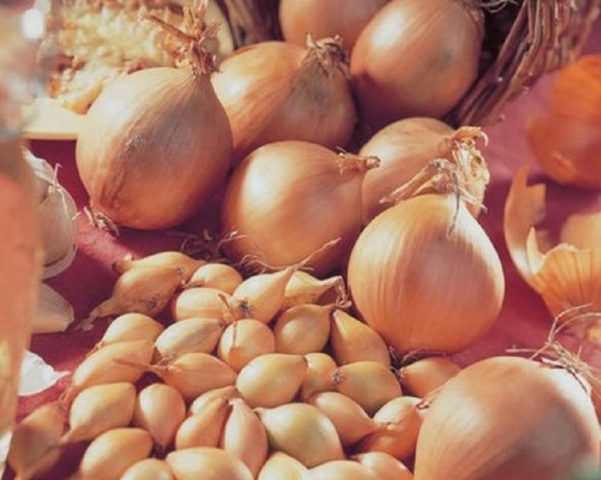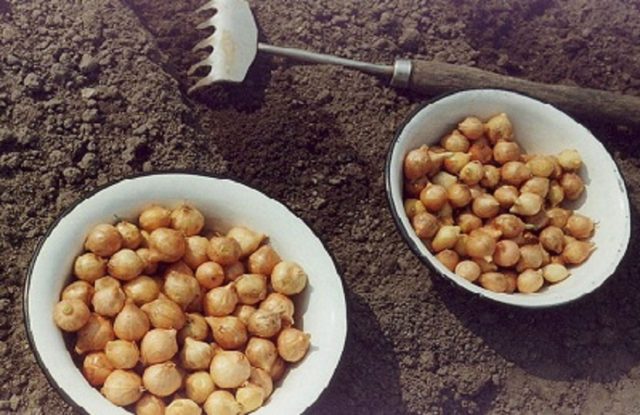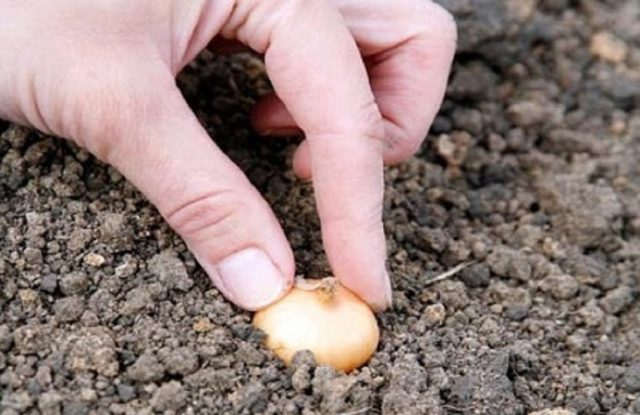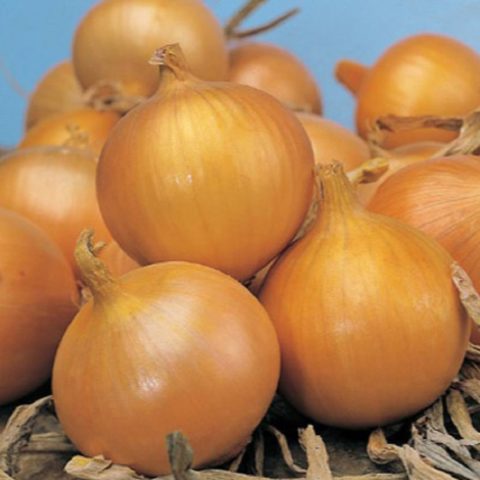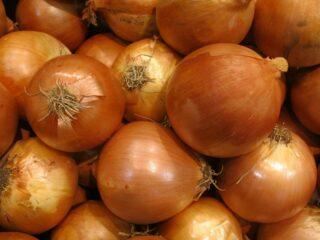Content
The Senshui onion is an early ripening hybrid of winter onions. Popular in many regions of Russia and Belarus. It has its own growing characteristics, which you need to familiarize yourself with before planting in the ground.
Breeding history of the variety
A winter onion hybrid was developed by Japanese breeders in the 70s of the last century. Scientists have taken care of creating an onion variety with quality characteristics.
Description of the Senshui onion variety
The main features that a grower needs to know are contained in the description of the Senshui onion. Refers to podzimny varieties. Plant up to 50 cm high with lush dark green feathers. Mature bulbs have a semicircular flattened shape, covered with dark golden scales. The taste of the bulbs is salad, sweet, in addition, they have a pleasant aroma without a pungent bulbous smell. It has a whole list of advantages, for which it is appreciated by vegetable growers.
The Senshui onion is a biennial crop. Onion sets are first grown from seeds, which are planted in the second year to obtain full-fledged bulbs.
Onion Sevok Senshui: variety description
When describing the Senshui onion, it is important to pay attention to the characteristics of the set. It is divided into categories by size:
- "Wild oat" - up to 1 cm;
- small has a size from 1 cm to 1.5 cm;
- the first category, differs in dimensions from 1.5 cm to 3 cm;
- the largest is the “sample”, the diameter of which is 3 cm or more.
The Senshui Bow has a trait that should be known. Large heads grow from the smallest planting material. It tolerates winter more easily and gives a good harvest. But the large sevok of Senshui is used to obtain greens. As soon as the warm days come, it actively sprouts and gives an early harvest of feathers.
Characteristics of the Senshui onion variety
The Senshui winter onion has good quality characteristics. Vegetable growers from different regions note its stable high yield, unpretentiousness and resistance to diseases.
Yield
Senshui is an early ripening variety. This explains its popularity among Russian vegetable growers. The climatic conditions of the regions and the length of the winter period lead to an urgent need for an early harvest of crops. Winter onion varieties are capable of providing a quick, high-quality harvest. It is harvested 2 months earlier than in the spring planting of spring varieties.
The yield of the variety is 4 kg of heads per 1 sq. m landing area. The weight of one onion reaches 150-180 g, with good agricultural technology, heads are harvested of 250 g each. The pulp is juicy, white. You can increase the yield by competently regulating the watering of the variety.
Disease and pest resistance
The originators in the description of the Senshui yellow onion indicate the plant's high resistance to powdery mildew.
Advantages and disadvantages of the variety
Based on feedback on the Senshui winter onion, you can compile a list of the pros and cons of the culture.
Advantages:
- Early ripening. The feather is ready for culinary use in early spring; when planted in the second year, the bulbs are ready to be harvested in the middle of summer.
- Frost resistance. The Senshui variety tolerates a drop in temperature to -15 ° C.In addition, even lower temperatures are not harmful if severe frosts are short-lived.
- Productivity, which is considered high enough for winter varieties.
- Taste qualities make it possible to use the vegetable not only in the preparation of fresh dishes, but also to preserve the bulbs.
- Storage and transportability are of a high standard. The Senshui lays up to 6 months without losing its qualities.
- Not subject to shooting.
- Unpretentiousness. Care consists of a short list of activities. And in the spring, the bulbs do not even need watering.
The disadvantage is the lower yield compared to spring varieties. Although a careful choice of planting material greatly increases this indicator. The second disadvantage is a short shelf life. But all early-ripening bulbous varieties have this drawback.
Planting and caring for onions
Planting winter onions has its own characteristics. For winter varieties, all recommendations must be carefully followed. Only in this case, you can count on a decent result. The following will present the basic requirements for planting and caring for the Senshui bow.
Onion planting dates
The Senshui winter sevok is planted in terms that depend on the climatic characteristics of the region. If these are the southern regions, then the optimal period is November. For the northern ones, the dates should be shifted by a month and a half and planting should be carried out in September or October.
Frozen soil will harm the planting material, and early planting can lead to premature germination.
Garden bed preparation
The place for the beds should be chosen carefully. The Senshui prefers a sheltered and well-lit area. The lowland is not suitable due to the accumulation of water when the snow melts. In such conditions, the bulbs begin to heat up quickly.
The garden bed is prepared in compliance with the crop rotation. Senshui can be planted no earlier than 5 years after the previous cultivation of legumes, bulbs and potatoes. Ideal predecessors are beets, carrots, cabbage, greens.
Preparation begins 2 weeks before the scheduled planting date. The soil is dug up with the simultaneous introduction of humus and mineral fertilizers, then the bed is left for the soil to settle.
Before planting, the bed is sprinkled with wood ash and a ridge 20 cm high is formed.
Planting onions
No preliminary preparation of the planting material is required. Sevok does not need to be soaked or trimmed.
In the prepared bed, you will need to make furrows. The depth of each is no more than 5 cm, and the distance between them is about 15 cm.
The Senshui onion set is placed along the furrow. It is important at the time of planting to ensure that the neck is 2 cm below ground level.The distance between the two bulbs is maintained no more than 15 cm.
From above, the seedlings are covered with earth, then with humus. Be sure to insulate the garden by laying a layer of spruce branches or sawdust. You do not need to water immediately. You can slightly moisten the garden bed after 10 days in dry weather.
Growing onions
Senshui onion care begins with the onset of spring. With a stable heat, the bed is freed from the covering mulch, then fertilized with urea. For 1 sq. m will need 10 g of the substance.
Then the soil is loosened and sprinkled with a thin layer of wood ash. After the formation of 4 leaves, the culture is fed with phosphorus (20 g per 1 sq. M) and potassium (10 g per 1 sq. M). The optimal method of fertilizing Senshui onions is considered to be watering with liquid solutions.
The beds are watered no earlier than May and as needed. Each watering is completed by gentle loosening.
Harvesting and storage
Ripening of the variety begins in early summer. Depending on the region of cultivation, the harvest period comes in June or July. For 2 weeks, stop watering and loosening. During this period, the heads gain maximum weight, and their scales dry out. Therefore, you should not stimulate the growth of greenery with such actions.
Cleaning begins before the leaves turn completely yellow.Otherwise, after the first rain, the Senshui will begin to form new roots.
The bulbs are carefully pulled out of the ground, laid out on the ground to dry. In dry weather, drying lasts a week. In addition to drying, the sun's rays have a disinfecting effect. After a week, the crop is sent under a shed and kept there for 20 days. These heads are better stored. During the rainy season, the crop is transferred to a well-ventilated, but closed room for drying.
Then a bulkhead is carried out. Intact, dense bulbs are laid for storage. The leaves are cut at a height of 5 cm from the neck. Then the roots are cut without touching the bottom. Place the Senshui in nets, baskets or boxes with ventilated walls. Many people make pigtails that make it easier to control the condition of the bulbs during storage.
Onion breeding methods
The Senshui onion variety belongs to hybrid forms, therefore it multiplies by planting sets. If you want to grow the planting material yourself, then the seeds should be purchased in specialized stores. Collecting seeds yourself is not recommended. With this method of propagation, hybrid varieties do not retain their characteristics.
Diseases and pests, methods of control and prevention
Before planting, the beds must be treated with tobacco thrips, nematodes, and onion flies. During the period of growing winter onions, it is necessary to regularly inspect the plantings. Before harvesting, the Senshui may be attacked by insects. Gardeners advise to stock up on "Aktara" or "Medvedoks". From folk remedies, they use infusions of marigolds, alkaloid lupine. Additionally, they frame the onion bed with rows of marigolds.
Conclusion
The Senshui onion is an excellent variety for private growers and farms. The onion is perfectly adapted to the climate of the middle zone, tolerates winter, gives an early harvest, and has a good taste. The ability to transport allows you to sell crops in other areas without loss.
And a little practice:
